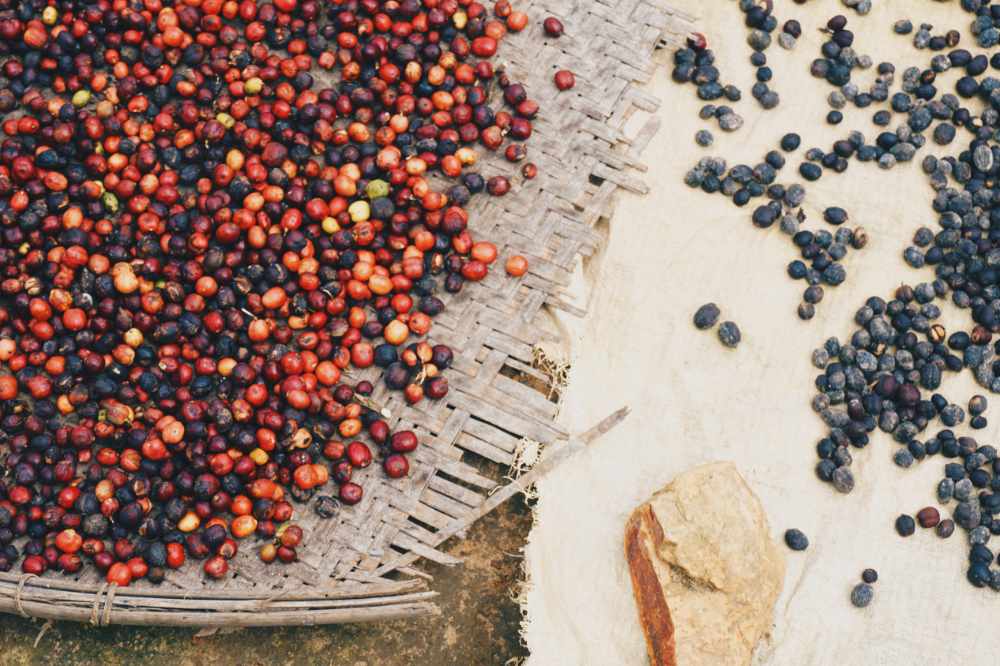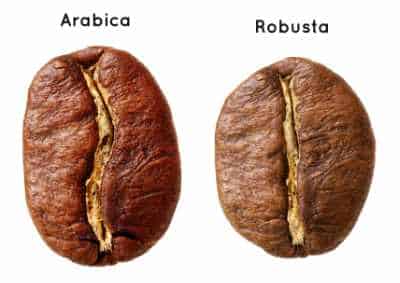When you are looking to try a new type of coffee, you will notice that some packages advertise that they contain 100% Arabica coffee. We’ve been told by other coffee lovers (who seem to know what they are talking about) that 100% Arabica beans are the kind to buy, but few have told us why. So, what sets Arabica coffee apart from the rest?
Arabica coffee is the most popular type of coffee and is responsible for more than half of all coffee production and consumption worldwide. Many coffee lovers choose Arabica coffee over Robusta because of its smooth taste and nuanced flavors. While Robusta coffee tends to be harsh and bitter, in Arabica coffee you can detect notes of chocolate, caramel, fruit, and berries.
We’ll let you know what makes Arabica coffee so popular and also let you in on some of the little-known facts of this popular bean.

The Types of Coffee Beans
While you may find a hundred different flavors, roasts, and coffee blends in just one aisle of your local grocery store, all the coffee in the world can pretty much be narrowed down to two types of beans. If you look at the ingredients, you’ll see that your bag of specialty coffee contains Arabica coffee beans, Robusta coffee beans, or a blend of the two.
Most Popular: Arabica coffee
Arabica is hands-down the best seller in the coffee world making up 60-75% of the world’s coffee production. Even Kona coffee which is one of the priciest and best coffees in the world is part of the Arabica club.
Depending on where it is grown, and how it is processed and roasted, you can get chocolate, caramel, fruit, nut, and even cereal or wine flavors out of this bean. The beans are larger than Robusta beans and contain more sugar. They also contain almost 60% more lipids than Robusta which helps to preserve their aroma and flavors during processing.
While Arabica offers superb flavors, the coffee plants require shade and high altitudes making them a more high-maintenance bean to grow.

The Runner Up: Robusta Coffee…
Robusta beans are from the coffee species Coffea canephora. The Robusta plant is responsible for about 40% of coffee production. The smaller coffee beans have flavors that are stronger and more bitter than Arabica. But on the upside, Robusta is lower in acidity, which means it may go a bit easier on the stomach. It also has much more caffeine than Arabica containing 2.2% caffeine per robusta bean according to coffeechemistry.com.
While Robusta coffee doesn’t offer the wide variety of flavors that you can get with Arabica, it is often used in Italian espresso blends. This quick brew method extracts the caffeine while leaving out some of the less desirable flavors of the Robusta bean. Robusta coffee is also capable of producing a thicker crema on the top of an espresso cup. This makes it a popular choice among espresso drinkers.
Robusta beans grow well at sea level and are cultivated in Africa, Indonesia, India, Latin America, Brazil, and Vietnam.
Thirdly, and Lastly: Liberica Coffee
It’s hard to believe that all the varieties out there and all the countries growing coffee that the beans come down to just two types in the end. So, if it makes you feel better, there are actually 3 types. There is another type of coffee from Liberia called Liberica, which grows larger beans with a strong taste. If you are wondering what taste, it is sometimes referred to as “liquid tobacco” if that is helpful. Liberica coffee is so rarely found that most forget to even name it among the types of coffee. Liberica merged with the other little-known type of coffee known as Excelsa in 2006 and makes up for 2-7% of the world’s coffee.
Where Does Arabica Coffee Originate? A Short History of the Beloved Bean
Arabica beans are from the Coffea arabica species of coffee. The arabica plant doesn’t originally hail from the Arabian peninsula, though. Instead, it has its origins in the higher altitudes of western Ethiopia. So why are the beans called Arabica?
While the beans were first discovered in Ethiopia, an Arab monk from Yemen first came up with the idea of cultivating and roasting the beans to give us the drink we know today. Since Yemen was situated nicely as crossroads between the Far East and Europe, they had the opportunity to pass on this life-changing drink to traders coming through the Mocha, Yemen port. The Typica seeds from the Arabica plant also began making their way from Yemen to the Malabar coast in India to Java, Indonesia, and onto other parts of the globe.
Arabica coffee grows best in higher elevations in tropical climates that maintain cool to warm temperatures. Arabica coffee is currently grown in countries such as Ethiopia, Yemen, Costa Rica India, Guatemala, Colombia, and Brazil.
What is the Caffeine Content in Arabica coffee?
Most of us coffee drinkers know that the caffeine content of your cup will depend on how it is brewed. When we order an espresso or a nitro cold brew we expect it to pack in more caffeine per ounce than a regular drip-brewed coffee or iced coffee. However, much of the caffeine content of your cuppa is determined before you brew. It begins with the type of coffee you choose.
There is a wide discrepancy between the caffeine content of Arabica coffee vs. Robusta coffee. An Arabica bean usually contains between 1.2% to 1.8% caffeine. This is up to 50% less caffeine than a Robusta bean. So whether you are limiting caffeine, or you want your coffee drink to pack a punch, you can choose your coffee type accordingly.
So, Is 100% Arabica Coffee the Way to Go? The Final Verdict
Arabica is known for its complexity, well-balanced flavors, and acidity. While in general, I’d much rather drink flavors such as caramel or chocolate than rubbery, bitter ones, each coffee type will have its own area of expertise.
Some things to take into consideration when deciding whether you should buy 100% Arabica, Robusta beans, (or a blend of the two) are:
- Caffeine content: As we mentioned, Arabica contains about 50% less caffeine than Robusta. If you enjoy drinking several cups of coffee over the course of the day, less caffeine in your cup will mean you can drink more of them. However, if the caffeine pick-me-up is more important than the flavor nuance, a good strong cup of diner-style Robusta coffee may be what you want.
- Acidity: Arabica has a higher percentage of acid overall than Robusta. Similar to a fine wine, the acidity in Arabica coffee can add to the sweetness and complexity of the coffee flavors. On the other hand, Robusta is known for having more chlorogenic acid. This acid is high in antioxidants but also adds more bitterness to your cup. If you want the flavors of Arabica coffee, with less acid, you can choose dark roasted Arabica beans or use a low-acid brew method such as cold brew.
- Quality: Another factor to consider when choosing your coffee is the quality of the beans you buy. While Arabica generally falls nicer on the palate than Robusta, a high-quality Robusta coffee may be a better choice than a lower quality Arabica.
- Brew method: Arabica coffee usually showcases better in brew methods such as drip coffee, percolated coffee, and pour-over methods. However, if you are wanting a rich crema on the top of your espresso, a Robusta or a Robusta-Arabica blend may be the way to go.
- Price: Robusta is a hardier coffee plant that grows easier around the world than Arabica. This means that Robusta coffee can be produced much cheaper than Arabica beans. As the consumer, you will pay the price for all the effort that went into growing your high-quality Arabica beans. Often, you will spend up to twice as much on a bag of Arabica coffee.
- Taste: When you stack up all the pros and cons of the Arabica bean, the ultimate deciding factor will be taste. In the continuous search for that perfect cup of coffee, your palate will discern which type of coffee and brew method it prefers.
FAQs
How much caffeine should I drink in a day?
Caffeine can be a great pick-me-up during the day and may even help in weight loss. However, the FDA suggests that healthy adults limit their caffeine intake to 400 milligrams a day. That comes to about four or five cups of coffee.
What is a low-acid coffee?
While the acid in coffee can be part of a good flavor profile, too much acid in your coffee can cause heartburn or stomach aches. There are many factors the decide how much acid your coffee will contain. These include the type of coffee bean (Arabica or Robusta), the roast, the origins of the coffee beans, and your water-to-coffee ratio. A darker roast or Robusta roast will give you less acid per cup.
What are some high-quality Arabica coffees?
Nothing beats a high-quality Arabica coffee in our book! One of our top picks is Lifeboost coffee. It’s 100% Arabica beans, 100% organic, and 100% clean. However, this coffee isn’t our only favorite. Check out some of our other recommendations and find the coffee that suits your tastebuds here.
Wrap Up
Whether you end up walking away with a bag of 100% Arabica coffee or choose the highly caffeinated Robusta, is your prerogative. While we tend to be partial to Arabica over 60% of the time, every now and then we do like mixing it up with Robusta to get a rich crema topping on our espresso. We’ve laid out the facts on these two types of coffee like the coffee nerds we are so you can find that above-average cup of coffee you deserve.





